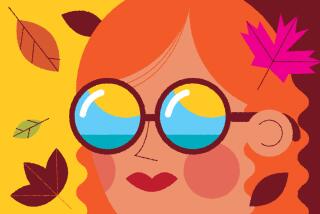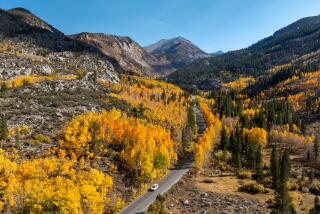Where to find fall colors in Southern California
Is anyone thinking about looking for fall colors around Southern California? I hope so. We all need a reason to cheer, rather than fear, Mother Nature right now.
At this time of year, most Angelenos head to stunning spots in the Eastern Sierra, such as Bishop Creek and the June Lake Loop, to see fluttering aspen leaves turn from lime green to gold.
But this year was difficult to plan because some national forests were closed; other areas experienced heavy smoke and hazardous air quality from active fires burning to the west. Californiafallcolor.com, which reports on good fall color spots around the state, can point you to places in the Sierra that are near or at peak right now.
Those staying closer to home shouldn’t feel left out. Partly opened local forests as well as botanical gardens and vineyards offer color changes that start now and continue through December. Here are places to visit — and return to as the season unfolds. Do you have a place to suggest? Email us at [email protected].
Los Angeles County
Ginkgoes are stunners in local gardens and on some city streets, turning from lime green to light yellow to deep gold before puddles of delicate, fan-shaped leaves appear at their base. Botanical gardens (you must buy tickets in advance) tend some of the best examples of the ancient trees from China.
Huntington Library, Art Museum and Botanical Gardens in San Marino (huntington.org/gardens): Look for the grove of a half-dozen ginkgoes in the Zen Court at the Japanese Garden. They turn gold around Thanksgiving and last into December. Ginkgo trees also line the sidewalk along Allen Avenue, leading to the Huntington’s entrance. There’s more color to be seen here, including a weeping willow that turns yellow during the cooler months.
Descanso Gardens in La Cañada Flintridge (descansogardens.org): Ginkgo trees are here too, including a notable one on the Promenade and in the Japanese Garden. The river birch trees in the Rose Garden are turning now, as are some fiercely red Japanese maples.
Los Angeles County Arboretum & Botanic Garden in Arcadia (arboretum.org): Gum trees, Eastern redbud, maples, California grape and sycamores bring yellows, golds, oranges and crimsons in late October. You may not see all the color at once; it’s worth a second trip to explore the 127-acre site.
San Bernardino County
Big Bear Lake has returned to the fall color lineup after national forest trails surrounding the town reopened Oct. 9. The town, 100 miles northeast of downtown L.A., asks visitors to come — provided they practice social distancing and wear masks when entering stores and businesses and or when passing someone by closer than six feet.
Here are places recommended by Big Bear’s tourism office and other sites. For more information, check out Big Bear Lake’s website.
- The Town Trail, a little more than 2 miles round trip, shows subtle gold, amber and orange tones from dogwood and oak trees. It’s an easy trail for walkers and bicyclists.
- Castle Rock Trail takes you through a pine and oak forest to views of the lake. There’s a steep uphill climb in the first half-mile of the hike; it’s 2.6 miles roundtrip. This popular trail can be crowded, so have a Plan B if you see too many people at the trailhead.
- Trent Vierra reports on californiafallcolor.com that low-lying serviceberry bushes in the Moonridge neighborhood are turning gold, along with black oaks that bring “beautiful autumn russet color.” Vierra also says big-leaf maple and cottonwood trees in Big Bear are turning too. Read the full report here.
- Aspen Grove Trail has one of the few stands of quaking aspen trees outside of the Sierra. Be prepared to drive on dirt roads to get to the trailhead 2.6 miles from Highway 38. Day hiking permits are required. More info here.
Riverside County
Grapevines bring color to the Temecula Valley, contrasting nicely with the rolling hills. These are planted areas, of course, but the effect is still worthy. Red and yellow leaves on the low-slung vines pop now through November at the 40 or so wineries in the valley, including those on Rancho California Road. Check out Thornton Winery at 32575 and South Coast Winery Resort & Spa at 34843. Wineries are open too, some with limited hours. Take a self-guided drive on one of nine itineraries from the Temecula Valley Winegrowers Assn. at temeculawines.org and click on “tours.”
San Diego
Balboa Park’s 1,400 acres are best known for housing museums, an enclosed botanical garden and the famed zoo. But many old trees, some that date to the Panama-California Exposition in 1915, thrive here too. Look for gold Fremont cottonwoods amid the many planted eucalyptus and bay figs. Also, check out the stand of liquidambar trees at 6th and Quince streets that turn from gold to purply red. Find maps and easy walking trails on the west side of the park at balboapark.org/enjoy/trails.
More to Read
Sign up for The Wild
We’ll help you find the best places to hike, bike and run, as well as the perfect silent spots for meditation and yoga.
You may occasionally receive promotional content from the Los Angeles Times.







